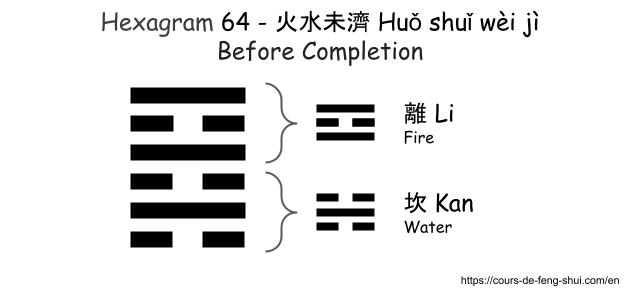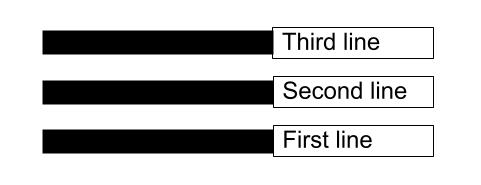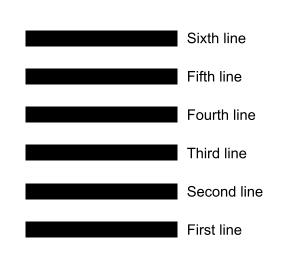
Composition of a Hexagram
The eight trigrams form the foundation of the 64 hexagrams.
1- What is a Trigram?
- Yin is represented by a broken line.
- Yang is represented by a solid line.

Trigrams are drawn and read from bottom to top:
- The first line represents Earth.
- The second line represents Man.
- The third line represents Heaven.

Each trigram symbolizes the trinity of Heaven, Earth, and Man through combinations of Yin and Yang.
The Eight Trigrams Are
- ☰ Qian 乾 – Heaven
- ☴ Xun 巽 – Wind
- ☲ Li 離 – Fire
- ☱ Dui 兌 – Lake
- ☷ Kun 坤 – Earth
- ☳ Zhen 震 – Thunder
- ☵ Kan 坎 – Water
- ☶ Gen 艮 – Mountain
Name and Image of a Trigram
It is important to know the name and image associated with each trigram.
For example, the trigram ☰ Qian 乾 represents Heaven.
The Eight Trigrams and Their Images
- ☰ Qian 乾 – Heaven
- ☴ Xun 巽 – Wind
- ☲ Li 離 – Fire
- ☱ Dui 兌 – Lake
- ☷ Kun 坤 – Earth
- ☳ Zhen 震 – Thunder
- ☵ Kan 坎 – Water
- ☶ Gen 艮 – Mountain
2-What is a Hexagram?
Each of the 64 hexagrams is created by combining two trigrams. By superimposing trigrams in pairs, we derive the 64 hexagrams.
2.1 Structure of a Hexagram
- An upper trigram
- A lower trigram
The lower trigram is called “the Inferior,” and the upper is called “the Superior.”
For example, in hexagram 64, the upper trigram is ☲ Li 離 (Fire), and the lower trigram is ☵ Kan 坎 (Water).

2.2 Reading a Hexagram
When naming a hexagram, we start with the image of the upper trigram, followed by the image of the lower trigram, and then its proper name.
It is important to know how to “read” the full name of a hexagram.
For example, hexagram 64 is named Fire on Water – WèiJì (or Before Accomplishment, as you prefer).
When you are learning, it’s important to make the effort to name a hexagram by its full name. This helps in fully understanding its structure and gradually memorizing it.
Example
Let’s take hexagram 64 of the Yi Jing: Before Accomplishment.
This hexagram is composed as follows:
- Upper trigram: ☲ Li 離 (Fire)
- Lower trigram: ☵ Kan 坎 (Water)
Traditionally, this hexagram is named in Chinese: 火水未濟 – HuǒShuǐ WèiJì.
Breaking down the name:
- 火 – Huǒ, meaning Fire, the image of the trigram ☲ Li 離
- 水 – Shuǐ, meaning Water, the image of the trigram ☵ Kan 坎
- 未濟 – WèiJì, often translated as Before Accomplishment.
The full name includes:
- Name of the upper trigram’s image
- Name of the lower trigram’s image
- Name of the hexagram
During divinations, after assembling your hexagram from the first to the sixth line, you name it by the upper trigram, the lower trigram, and the hexagram’s name before beginning your analysis, regardless of the method (comments, Wen Wang Gua, etc.).
2.3 Writing a Hexagram
A hexagram is drawn from bottom to top, starting from the first to the sixth line.
During divinations, you write your hexagram from bottom to top.

3-Interpretation of the I Ching Readings
There are several methods for interpreting a hexagram; the most common among Westerners is the one with comments. It requires studying the comments on the opposite, inverted, nuclear, and mutant hexagrams of your drawing.
Opposite Hexagram 錯卦
This hexagram is obtained by replacing the Yin lines with Yang lines and the Yang lines with Yin lines.
Inverted Hexagram 覆卦
This hexagram is obtained by swapping the upper and lower trigrams.
Nuclear (Mutual) Hexagram 互卦
This hexagram is formed by taking the four central lines of the hexagram to create two trigrams. Lines 2, 3, and 4 form the lower trigram, and lines 3, 4, and 5 form the upper trigram.
Hexagram of Change (Moving/Changing Lines) 變卦
The mutant or derivative hexagram arises from the mutations of each line.